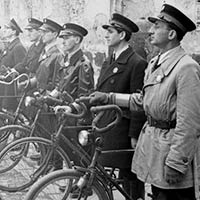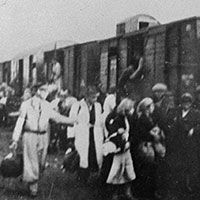Józef Szeryński / Josef Szynkman
Jozef Andrzej Szerynski, or Szenkman or Szynkman, born in 1893 or 1892, died in 1943 in Warsaw - a police-colonel of the State Police, from December 1940 the first commander of the Jewish Ghetto Police German: Jüdischer Ordnungsdienst, literally Jewish Order Service, customarily Jewish police - during World War II, they ware partially subordinate to the Judenrat, collaborating with Nazi Germany, Jewish Police units operated inside ghettos, labor camps and concentration camps. The police dealt with requisitions, round-ups of other Jews, escorting displaced people and deportation actions. (commonly known as the "Jewish police") of the Warsaw Ghetto, considered a traitor and Nazi collaborator who directly facilitated the extermination of the ghetto population by the Germans.
German: Jüdischer Ordnungsdienst, literally Jewish Order Service, customarily Jewish police - during World War II, they ware partially subordinate to the Judenrat, collaborating with Nazi Germany, Jewish Police units operated inside ghettos, labor camps and concentration camps. The police dealt with requisitions, round-ups of other Jews, escorting displaced people and deportation actions. (commonly known as the "Jewish police") of the Warsaw Ghetto, considered a traitor and Nazi collaborator who directly facilitated the extermination of the ghetto population by the Germans.

The Jewish police under the command of Szeryński was responsible for the beatings and persecutions of the ghetto inhabitants, participated in searches and arrests, and in gathering deportees to the Umschlagplatz before sending them to extermination camps. At Szerynski's order, the Jewish police made sure that the children and the sick were deported in the first place, because they were the weakest.
As the commander of the Jewish police, Szeryński was a privileged inhabitant of the ghetto and was even exempt from wearing the Star of David armband. He was widely regarded as corrupt and engaging in black market activities. He was known for his explosive disposition and aggression towards the policemen of the Jewish ghetto under his command. He called the Jews "animals" and "cows."

Obwieszczenia były początkowo podpisywane przez władzę gminną, wkrótce jednak zaszczyt mordowania swojego narodu przypadł w udziale całkowicie służbie porządkowej. Naczelnym katem zaś mianowano pułkownika Szeryńskiego.
I must, unfortunately, immortalise the name of this contemporary of Herod. He was of Jewish descent, before the occupation a Polish police officer. He was a tough and strong man, possessed of a thunderous voice and a commanding demeanour. He made the impression of a condottieri. Not devoid of personal charm, he gave the impression that he could be brutal. He brought a certain discipline to the Order Service. He satisfied, to a certain extent, the need for a uniform that has arisen in modern societies, including among Jews.
During an action to give furs to the Germans, he committed an awkwardness: he sent some fur that was of little value outside the walls. It got out, he was arrested and imprisoned in the Pawiak prison. He was threatened with the death penalty. It was given to him on condition that he lead the action of leading the tribesmen to slaughter. Did he know it was for slaughter? Perhaps not at first, but later there was no doubt.
He could have stood at the head of the only organised combat unit and died in such a way that his name would have been reverently pronounced by his own and by his enemies. He was not up to it. And that is why he died like Judas.
On May 1, 1942, the Germans arrested Szeryński, accusing him of stealing furs confiscated from the ghetto inhabitants. His deputy, Jakub Lejkin, temporarily took his place as the commander of the Jewish police. However, Szeryński was released when the Germans realized they needed his services to organize the mass deportation of Jews from the ghetto to the Treblinka extermination camp Treblinka extermination camp - a German Nazi death camp in operation from July 1942. The extermination of the Jewish population was carried out there. The Germans sent him mainly transports from ghettos in occupied Poland, including the Warsaw ghetto. Moreover, Austrian, Czech, Greek, Yugoslav, German and Slovak Jews as well as Roma and Sinti were murdered in Treblinka. Victims were killed in stationary gas chambers using flue gases. The number of victims of Treblinka probably reached around 800,000. people. It was the largest extermination center in the General Government and the second, after Auschwitz-Birkenau, in occupied Europe..
Treblinka extermination camp - a German Nazi death camp in operation from July 1942. The extermination of the Jewish population was carried out there. The Germans sent him mainly transports from ghettos in occupied Poland, including the Warsaw ghetto. Moreover, Austrian, Czech, Greek, Yugoslav, German and Slovak Jews as well as Roma and Sinti were murdered in Treblinka. Victims were killed in stationary gas chambers using flue gases. The number of victims of Treblinka probably reached around 800,000. people. It was the largest extermination center in the General Government and the second, after Auschwitz-Birkenau, in occupied Europe..
The Jewish underground made unsuccessful attempts to liquidate Szeryński. He headed the ghetto police until the end of the Great Action Wielka Akcja - (niem. Grossaktion Warschau) – akcja likwidacyjna getta warszawskiego połączona z masową eksterminacją jego mieszkańców).
Wielka Akcja - (niem. Grossaktion Warschau) – akcja likwidacyjna getta warszawskiego połączona z masową eksterminacją jego mieszkańców).
Szeryński committed suicide by consuming cyanide.